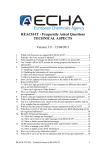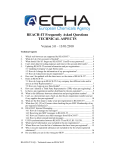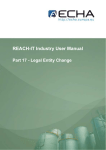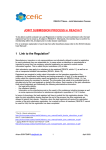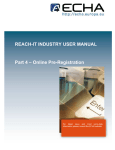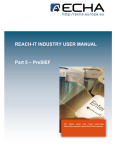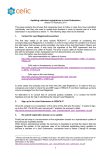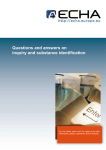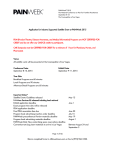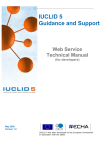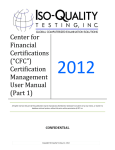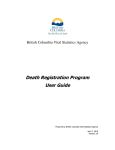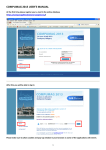Download ECHA - CLP Technical FAQ December 2010
Transcript
REACH-IT - Frequently Asked Questions TECHNICAL ASPECTS Version 3.5 – 20/10/2010 1. 2. 3. 4. 5. 6. 7. 8. 9. 10. 11. 12. 13. 14. 15 16 17 18 19 20 Which web browsers are supported by REACH-IT? ......................................... 4 What do I do if my account is blocked? ............................................................ 4 What should I do if I forget my REACH-IT UserID or my password? .............. 5 Can I enter data for testing purposes and remove the account afterwards?......... 6 Updating REACH-IT account information and pre-registrations ....................... 6 5.1 Updating Company’s Legal Entity name..................................................... 7 5.2 How do I change the information of my pre-registration?............................ 7 5.3 How do I delete my pre-registration? .......................................................... 8 5.4 How to deactivate your pre-registration in your pre-SIEF?.......................... 8 How can I be updated with the latest news or the status of REACH-IT?............ 9 Roles in REACH-IT ......................................................................................... 9 7.1 How do I sign up in REACH-IT if my company has different roles and/or acts as an Only Representative? ........................................................................ 9 7.2 How can I sign-up as a Data Holder? ........................................................ 10 How can I identify a Third Party Representative (TPR) when pre-registering? 11 Is there a pre-registration number distributed to the pre-registrant? ................. 12 What is the difference between submission and pre-registration number? ....... 13 Can I, as a downstream user, check on-line the pre-registration number and see if my supplier has pre-registered? ................................................................... 13 What are the first steps to make a late pre-registration in REACH-IT? ............ 13 What does [A], [F] or [I] mean when checking the pre-SIEF Membership of my pre-registered substances?............................................................................... 14 REACH-IT Internal Messaging....................................................................... 14 14.1 How do I manage my messages?............................................................. 14 14.2 Receiving pre-SIEF messages in REACH-IT .......................................... 15 14.3 How can I retrieve my older messages from REACH-IT? ....................... 15 14.4 How to delete unread internal messages .................................................. 16 UUID synchronisation between REACH-IT and IUCLID 5 LEOX................. 16 15.1 How to manage your LEOX.................................................................... 17 15.2How to update your LEOX information ................................................... 18 What kind of information was included in the pre-registrations? ..................... 18 Where/How can I see the list of substances that have been pre-registered?...... 19 Why is my pre-registered substance not included in the list of pre-registered substances?..................................................................................................... 19 Do you think you are in the wrong pre-SIEF? ................................................. 19 Joint Submission Object (JSO) ....................................................................... 20 REACH-IT FAQ – Technical issues in REACH-IT 1 21 22 23 20.1 . How to confirm the membership to a Joint Submission before submitting a registration dossier? ........................................................................................ 20 20.2 How to delete a Joint Submission Object (JSO)....................................... 21 20.3 What should I do if I incorrectly enter my Joint Submission name/token? 21 Working with Classification and Labelling (C&L) notifications...................... 21 21.1 Who has to submit a C&L notification? .................................................. 21 21.2 How to prepare and what to submit in a C&L notification? ..................... 22 21.3 Using XML Bulk notifications ................................................................ 22 Legal Entity Change (LEC) ............................................................................ 23 22.1 What are the differences between “transferred pre-registrations” and “transferred registrations” when my Legal Entity Change is completed?......... 23 22.2 How do I see the history of a dossier and the related Legal Entity/Company name changes?................................................................................................ 23 Avoiding Business Rules in REACH-IT ......................................................... 24 23.1 Substance Identification .......................................................................... 24 23.2 Use of the TCC plugin of IUCLID 5 ....................................................... 24 23.3 Token and Joint Submission management ............................................... 24 23.4 Tonnage band ......................................................................................... 25 23.5 Dossier Management............................................................................... 26 KNOWN ISSUES ................................................................................................... 27 Known issue #1: Tonnage band information for registrations of intermediates displayed incorrectly in Reference Number History................................................. 27 Known issue #2: Using the navigation buttons of your web browser in a C&L notification via REACH-IT might generate a business rule failure........................... 27 Known issue #3: Substance identity name for a multi-constituent substance cannot be edited in the inquiry and the C&L online notification functionalities ....................... 27 From version 3.4, this new version includes: Questions amended: #2, #3, #6, #15 intro New questions added: #23, Known errors #2 and #3 From version 3.3, this version includes Questions amended from previous version: #20, #21, #21.1 Questions added: #20.1, #20.2, #20.3, #22.1, #22.2 From version 3.2, this version includes Questions amended from previous version: #5.1, #11, #15.1, #15.2 Questions added: #21 and Known issue #1 From version 3.1, this version includes: Question #5.3 became #5.4 Questions added: new #5.3 From version 3.0, this version includes: Questions amended from previous version: #5.1, #5.3, #6, #7.2, #15 Questions added: #15.1, #15.2, #20 From version 2.2 to version v3.0 (13.01.2010) includes: Questions amended from previous version: #2, #5.1, #5.3, #6, #9, #12, #16, #19 Questions added: #14.3, #14.4, #7.2 REACH-IT FAQ – Technical issues in REACH-IT 2 Questions removed: Known error #1,#2,#3 and #4 In this version question #7 becomes #7.1 Version v2.2 includes: Questions amended from previous version: #5.2 Question added from previous version: #19 Known errors added from previous version: #3, #4 Version v2.1 includes: The numbering of the questions has been changed: #1 is former #15 and so on… Questions amended from previous version: #5 (former #19) Questions removed from previous version: former #29 REACH-IT FAQ – Technical issues in REACH-IT 3 TECHNICAL ASPECTS IN REACH-IT 1. Which web browsers are supported by REACHIT? The only web browsers supported by the REACH-IT system are: • • 2. Microsoft Internet Explorer 6.X and above Mozilla Firefox 2.X and above What do I do if my account is blocked? If you are an “Organisation Manager” and you block your REACH-IT account, please go to the ECHA website at http://echa.europa.eu/about/contact-form_en.asp and select the REACH-IT web form, indicating that your account is blocked and identifying your userID so that it can be unblocked. ECHA will create a so-called “ticket” assigning it a “incident number” to follow up your case. Be aware that unblocking an account always triggers the reset of the password indicated in the REACH-IT account. The REACH-IT system will always send an automatic e-mail with the new password (valid for 5 days) only to the e-mail address specified in the REACH-IT account. If you do not have access to the email address that was indicated in the REACH-IT account, there are two approaches to take into consideration: 1. If you know which is the email address that was specified in the REACH-IT account but you do not have access to it anymore (i.e. the person who created it does not work in the company any longer) ask the ICT department of your company to re-create that email account so that when you reset the password of your REACHIT account, you will have access to the email containing the new REACH-IT password. 2. If you cannot recreate the email account, in order to confirm the eligibility of your request and verify your identity, ECHA will request you to submit a registered letter to ECHA indicating the following information: • • • • Incident Number provided by the ECHA Helpdesk The REACH-IT User ID Name and e-mail address of the new Organisation Manager The reason for this change. Remember that the letter has to be signed by the person authorized to sign on behalf of your company. If you decide to send the letter, please address it to: ECHA Helpdesk, European Chemicals Agency, P.O.Box 400, 00121 Helsinki, Finland REACH-IT FAQ – Technical issues in REACH-IT 4 IMPORTANT NOTE The letter will take few days to arrive to ECHA and few days to be processed. In case you are close to the registration deadline, it might be not feasible in time to unblock your account. ECHA will not make any changes or unblock REACH-IT accounts that have not been properly identified as described in this paragraph. It is your responsibility as Organisation Manager of your REACH-IT account to ensure that the data contained in your account is updated and correct. If the e-mail address specified in your REACH-IT account is correct and you do not receive a new password, please note that your e-mail management system might be filtering all incoming e-mails from the domain "echa.europa.eu" and considering them as SPAM. Contact your System Administrator in order to confirm that you have no restrictions to receive e-mails from our domain and try the functionality again. During the first login, the new automatic password will have to be changed. Remember that the “CAPTCHA” used to confirm the login does not affect the number of attempts to login; therefore it is not a cause of blocking an account. Under no circumstances should you send your REACH-IT account password via e-mail. If there is any problem with it, the password can be reset, but we advise you not to send it to anyone including the European Chemicals Agency. 3. What should I do if I forget my REACH-IT UserID or my password? If you are not an “Organisation Manager” and you do not know your password or your account is blocked, please remember that your “Organisation Manager” is able to unblock your account for you. Find out who is the responsible person within your organisation and he/she will be able to reset your password/unblock your account. If you are the REACH-IT Organisation Manager of your Company, ECHA highly recommends that after three unsuccessful attempts to login into the system, and in order to avoid blocking your account, you use the link “Forgot your User ID or password?” available in the Login page as shown in the following figure: Figure 60: Login screen in REACH-IT REACH-IT FAQ – Technical issues in REACH-IT 5 Figure 61: Request lost password screen IMPORTANT NOTE Before blocking your REACH-IT account, reset your password! Following the link in order to reset your REACH-IT account password yourself is a few seconds process that will provide a new password within few minutes. A new password is generated by the REACH-IT system (which is valid for 5 days) and is automatically sent to the email address indicated in the REACH-IT account. ECHA highly recommends Organisation Managers to verify that the email address indicated in their account is correct, otherwise, they must update the data now! For security reasons, REACH-IT has a limited number of attempts (5) to login into the system. Errors typing the CAPTCHA do not affect the number of attempts limit. If you do not remember your REACH-IT UserID, please contact the ECHA Helpdesk. 4. Can I enter data for testing purposes and remove the account afterwards? Unfortunately it is not possible to create testing accounts in REACH-IT. In the future we aim to have a training site so that companies can test their submissions and perform training. Unfortunately, we cannot modify live data in the system. Therefore users must not create accounts that are not real at this stage. 5. Updating REACH-IT account information and preregistrations If you need to update your REACH-IT account information, go to the main menu and select Company >> View and in every different Tab, you will find all the information related to your account which you will be able to modify by clicking in the button “update” REACH-IT FAQ – Technical issues in REACH-IT 6 5.1 Updating Company’s Legal Entity name Note that in order to change the Company name (party name) users need to select Company >> View and then access the Company Information Tab and click on the “update name” link. A new window will allow users to select a new legal entity name and accept a declaration where users are invited to attach (in .pdf format) an extract from the commercial register showing the change of name of the company that the user represents. Once the declaration is submitted the company name will be changed automatically. It should however be noted that ECHA and Member State Competent Authorities can verify the authenticity of the information submitted evidencing the name change. Note that the previous name will remain in the “Name change history” section in the Company Information tab with a link to the documentation provided to ECHA proving the reasons for the change. Please note that this name change functionality should not be used in cases where the change of name is due to a change of legal personality (as a result of a merger, company split, change of only representative, or the purchase of assets). A practical guide describing the differences between name change and legal entity change is available at http://echa.europa.eu/publications_en.asp - Fact sheets Practical guide on How to report changes in identity of legal entities. A user manual on the IT tool functionality used to communicate to ECHA a Legal Entity change can also be found at http://echa.europa.eu/reachit/supp_docs_en.asp REACH-IT - Industry User Manual Part 17: Legal Entity change. The concept of Legal Entity is defined by the national laws of each EU Member State. Companies that require communicating their Legal Entity change are advised to contact their National Helpdesks to clarify the scenario applicable to their specific cases according to national requirements. Note: A change of company name in REACH-IT will require also a modification of your official LEO in IUCLID 5. Further information regarding the synchronisation between REACH-IT and IUCLID 5 LEO can be found in question 15 of the current FAQ – Technical Issues in the ECHA website at http://echa.europa.eu/reachit/reachit_faq_en.asp 5.2 How do I change the information of my preregistration? The owner of a particular pre-registration can modify all the information in it with the exception of the Substance ID and the UUID assigned to that pre-registration. This means that contact information (both internal contact of the owner and possible third party representative), similar substances, envisaged tonnage band, envisaged REACH-IT FAQ – Technical issues in REACH-IT 7 registration deadline and the information field for the pre-SIEF may be updated if needed. For instance, in order to change the Contact Information, users need to go to the menu Pre-registration >> View pre-registrations and then select/search for the appropriate pre-registration number. Once in the pre-registration, select the Contact Tab and click the “Edit” button in order to update contact information or add a new contact person. If you need to change the tonnage band or the deadline, users only need to access the appropriate tab following the same procedure as described in the previous paragraph. All these modifications will update the information in the pre-SIEF as well. Users may check their pre-registrations in the pre-SIEF in order to confirm that the data has been updated as requested. Users will get a message in their message box announcing the modifications made to each pre-registration. 5.3 How do I delete my pre-registration? Such functionality is not available in REACH-IT. Therefore pre-registrations cannot currently be deleted from your REACH-IT account. Also the procedure to request deletions on pre-registrations has been discontinued. Please note that the list of pre-registered substances published on the ECHA web page only includes substances that were pre-registered before the pre-registration dead-line of 1 December 2008. During the pre-registration period from 1 June 2008 to 1 December 2008 companies were able to request the deletion of their pre-registration by sending a formal request to ECHA (accompanied by the submission report). The purpose of this was principally to help ECHA to improve the quality of the published list of pre-registered substances. It is important to note that because pre-registration does not imply any obligation to register the substance, there is no need for companies to request ECHA to delete their pre-registrations. In case you have no interest in registering the substance(s) the procedure suggested by ECHA is to de-activate the pre-registration. Note, however, that even as a non-active participant to the pre-SIEF forum a company may still be asked to share data in the SIEF(s). Of course companies are not obliged to request and pay for data that are not needed for their own registration purposes. Further information on technical aspects of deactivation can be found in question #5.4 of this REACH-IT Frequently Asked Questions – Technical Aspects 5.4 How to deactivate your pre-registration in your pre-SIEF? Pre-registrations can be de-activated from the pre-SIEF forum to indicate that your company will not be interested in actively participating in the pre-SIEF discussions, for whatever reason. Note, however, that even as a non-active participant to the preSIEF forum a company may still be asked to share data in the SIEF(s). Of course REACH-IT FAQ – Technical issues in REACH-IT 8 companies are not obliged to request and pay for data that are not needed for its own registration purposes. In order to deactivate, please go to the main menu on the left and: 1. 2. 3. 4. Go to Pre-SIEF and click on View Pre-SIEF membership Search for your pre-registration Select it by clicking in the link of the Pre-SIEF for substance column On the bottom of the page, several buttons will appear. One of them is the “Deactivate” button. Click on it. 5. Confirm the deactivation to finalise the process. The pre-registration and the future registration are not affected by the de-activation from the pre-SIEF forum. Also the right to benefit from extended registration deadlines is not related to the pre-SIEF status (i.e. whether it is active or not). The “Status” column that describes the status of your participation in the pre-SIEF will turn into a [I] indicating that you are inactive “Deactivated” from it. The same way, users can re-activate their membership in the pre-SIEF discussions by clicking the button “Activate” in the bottom of the page. The status for this case is [A]. If a pre-registration is updated while your status is inactive in REACH-IT, the system will change automatically the status of that pre-registration to active. In case a member of a pre-SIEF is the SIEF Formation Facilitator, the status would be [F] Note that the “deactivation” button is not enabled for the potential registrant if a Third Party Representative was appointed for a particular pre-registration. In that case the deactivation should be performed by the Third Party Representative, not by the potential registrant. 6. How can I be updated with the latest news or the status of REACH-IT? We advise you to regularly visit our website, check the latest news at http://echa.europe.eu/news_en.asp. We also recommend that you subscribe to our weekly e-News by sending an email to [email protected] Please remember that you can always be updated with the current status of the REACHIT on the REACH-IT section of our website: http://echa.europa.eu/reachit_en.asp 7. Roles in REACH-IT 7.1 How do I sign up in REACH-IT if my company has different roles and/or acts as an Only Representative? Currently, there are four ways to sign-up in REACH-IT: REACH-IT FAQ – Technical issues in REACH-IT 9 - As a Company - this is also the correct way for the Only Representative (OR) as the REACH-IT system does not differentiate between OR and manufacturers or importers. As a Data Holder – this is any person holding information/data relevant to a phase-in substance and willing to share it in the SIEF with other SIEF members. As an Interested third party – this is any person holding information/data relevant to substances appearing in the list referred in Article 28(4) of the REACH Regulation. As Third Party Representative. Third party representatives should not be confused with the OR and cannot make pre-registrations on their own and the functionalities in REACH-IT reserved for them are limited. If an OR represents more than one company, the OR will have to sign-up as a “Company” as many times as the OR represents non-Community manufacturers. It is not possible to use the same Legal Entity Object (LEO) having the same company UUID for multiple accounts, but it is possible to use the same company identification information (name, VAT, address, etc...). Only Representatives may consider adding a numerical or other identifier to their company name when signing up in REACH-IT, to facilitate the management of different legal entity accounts. Note that in the "Company Size" field, the OR must indicate the size of the nonCommunity manufacturer they are representing. Only Representatives can provide different contact details for each account. Note that for the “company size”, the OR must indicate the size of the noncommunity manufacturer they are representing. We recommend users taking a look at the Pre-registration Q&A document published on our website at http://echa.europa.eu/pre-registration_en.asp where more information regarding the pre-registration process is available. We invite users to read the Guidance on Data Sharing available on our website at http://guidance.echa.europa.eu/guidance_en.htm where section 3.4 describes who can pre-register and defines the different roles. In case you need to perform any changes in your REACH-IT account or the preregistrations made, please take a look at question #5 in this document. 7.2 How can I sign-up as a Data Holder? If your substance is already pre-registered as a phase-in substance (you are able to check this from the list of pre-registered substances available at http://apps.echa.europa.eu/preregistered/pre-registered-sub.aspx), you can identify yourself as data holder according to Article 29 of the REACH Regulation. There is a mechanism in place which enables you to lodge a request to ECHA with a view of being a participant in the SIEF for that substance, to the extent that you will provide information to other SIEF members. Please refer to section 4.2.2 of the Guidance on data sharing available in the ECHA website at: http://guidance.echa.europa.eu/docs/guidance_document/data_sharing_en.htm?time=1 237813567. REACH-IT FAQ – Technical issues in REACH-IT 10 You can create your http://echa.europa.eu/reachit Data Holder account in REACH-IT via After you have created the Data Holder account and signed in to REACH-IT, you can submit information/data through the "Phase-in information" menu on the main navigation bar on the left of the REACH-IT homepage. You should clearly identify the substance as well as any related similar substances (for read-across purposes and to increase the possibility that potential registrants are able to contact you). Provide information on your substance, either by EC#, CAS RN or chemical name. You have to repeat the same for all substances for which you have data. This will allow members of the relevant SIEFs to see that you are in possession of data that may be relevant to them, thus giving them the option to contact you. However you, as the data holder, will not be able to see any details of the SIEF. Also, you should enter your contact details carefully, as this will be the only way for registrants to get in contact with you. As a data holder, you will not see any contact details of the potential registrants, and therefore you will have to wait to be contacted. In REACH-IT the potential registrants are able to see the contact details of Data Holders. Consequently, if your contact details are incorrect, pre-registrants will not be able to reach you. Also ECHA recommends filling in the "Remarks" field as accurately as possible since this information will indicate to potential registrants the information you are willing to share. Finally you should validate your actions in the last tab of that menu. Note that REACH does not provide for data holders to have an active role in deciding on the studies to be included in joint submissions and on classification and labelling proposals. Data holders can thus only provide data to active members (potential registrants) of the SIEF and request cost sharing for the data supplied. 8. How can I identify a Third Party Representative (TPR) when pre-registering? In order to be able to select a TPR during late pre-registration, the TPR needs to have signed-up in REACH-IT in advance so that his UUID “Universal Unique Identifier” can be selected. Users can obtain a UUID from the IUCLID 5 website http://echa.europa.eu/iuclid or from REACH-IT. • You first need to ensure that the TPR signs up in REACH-IT, thereby obtain his/her UUID online directly from REACH-IT or from the IUCLID 5 website at http://echa.europa.eu/iuclid and then upload that UUID during the sign up in REACH-IT. • The TPR then needs to communicate his/her UUID to you. REACH-IT FAQ – Technical issues in REACH-IT 11 • You are then able to make a link to the TPR in your late pre-registration using the UUID. This is done selecting the tab labelled as “representative”. • The TPR will be then entitled to act on your behalf within the associated preSIEF and data sharing process. The contact details of the third party representative will then be made visible in the pre-SIEF for other preregistrants to be contacted. Note that a company using a TPR will be able to see both names in the Pre-SIEF (their TPR name and after that, their name in brackets). However, only the TPR’s name will be visible to the other participants in the Pre-SIEF, keeping the identity of the registrant hidden and safe. 9. Is there a pre-registration number distributed to the pre-registrant? Yes. For each successful pre-registration of a substance submitted to ECHA, REACH-IT assigns a pre-registration number to it. This number is unique for every company and pre-registered substance. The structure of the pre-registration number is: <TYPE>-<BASE-NUMBER>-<CHECKSUM>-<INDEX-NUMBER> Example: 17 - 1234567890 - 49 – 0000, where: • • • • 17 is the late pre-registration type 1234567890 is the random unique 10-digit number 49 is the calculated checksum (variable 2-digit number) 0000 is the index number This structure is of the same basic format as the other registration and notification numbers that REACH-IT will provide. For further information please read the REACH-IT Industry Manual Part 6: Dossier Submission available at http://echa.europa.eu/reachit/supp_docs_en.asp where chapter 2.4.2 describes this subject in detail. Note that the late pre-registration deadline expired on 30th November 2009 for certain types of substances and for substances imported/manufactured in quantities of more than a thousand tonnes as explained in the News Alert from 14/10/2009 at http://echa.europa.eu/doc/press/na_09_21_late_prereg_ends_final_20091014.pdf. For further information about this, please visit http://echa.europa.eu/reachit/pre-registration-it_en.asp REACH-IT FAQ – Technical issues in REACH-IT 12 10. What is the difference between submission and pre-registration number? The submission number is a unique number generated per each submission - as mentioned in Article 20 of the REACH Regulation. It is issued at every submission using the format “FD120238-61”. The pre-registration number is a unique number generated per each pre-registered substance and company. It is issued only once at the end of the initial, and successful, submission of a pre-registration. The format used in this case is 05-1234567890-77-0000 (for those pre-registrations before 02/12/2008) or 17-1234567890-77-0000 for late pre-registrations. 11. Can I, as a downstream user, check on-line the pre-registration number and see if my supplier has pre-registered? No, there is no functionality planned for REACH-IT that would accommodate and distribute such information as this information could be considered as confidential business information. Downstream users may wish to make appropriate contractual arrangements with their suppliers to ensure that they comply with REACH and that pre-registration takes place within the pre-registration period. As a general reference, downstream users have the possibility to consult whether a substance is included in the list of substances to be registered in 2010. Further information about how to do this can be found in the ECHA website at http://echa.europa.eu/doc/press/na_10_18_dcg%20_du_20100416.pdf. 12. What are the first steps to make a late preregistration in REACH-IT? According to Article 28(6) of the REACH Regulation, potential registrants who manufacture or import for the first time a phase-in substance in quantities of 1 tonne per year or more after 1 December 2008 can submit a late pre-registration if they do so within 6 months of first manufacturing or importing the substance above the 1 tonne threshold per year and at least 12 months before the relevant transitional registration deadline. First-time manufacturers or importers will therefore have to submit their late pre-registrations before 1 December 2009, 1 June 2012 or 1 June 2017, depending on their relevant situation as described in chapter 3.6 of the Guidance on Data Sharing available at http://guidance.echa.europa.eu/guidance_en.htm. Late pre-registrations cannot be considered as a substitute of pre-registrations that failed to meet their deadline. Please take a look at http://echa.europa.eu/reachit/pre-registration-it_en.asp, especially Industry User Manual – Part 4: Online Pre-registration. When pre-registering a substance in REACH-IT, users are invited to search for their substance by giving the EC number, EC name, a brief description or the molecular formula in a web form. REACH-IT FAQ – Technical issues in REACH-IT 13 Users should carefully search their substance identifier data to ensure that their substance (or constituent) is listed in the EC inventory. However, if users do not have any of these data or the constituent is not listed in the EC inventory, they can specify the substance either by its CAS number and CAS name or by only its chemical name by clicking on the two links available in the page. Please note that you will receive an error if you just try to search the EC inventory using that CAS number and not access the provided links. 13. What does [A], [F] or [I] mean when checking the pre-SIEF Membership of my pre-registered substances? [A] stands for active, [F] stands for pre-SIEF facilitator and [I] stands for inactive. [I] does not mean that the pre-registration was not successful, only that the company has de-activated itself from the pre-SIEF forum. 14. REACH-IT Internal Messaging 14.1 How do I manage my messages? All communications are done through an internal messaging system. Internal messages are different from emails. They are generated by the REACH-IT system and delivered to the user’s message box inside REACH-IT. The aim of the internal messages is to inform, request actions from, or to provide feedback to the user. All REACH-IT users have their own inbox where they can access messages directed to them personally, to their group (users with the same role) or party. REACH-IT FAQ – Technical issues in REACH-IT 14 Additionally, if you want to receive alerts when a message is received in the internal message system, you can define this as an option in your User preferences. The notification of the reception of such messages via email can be configured so that: • • • The user does not receive any notification of any internal message received in the REACH-IT system (default setting), The user receives a notification every time an internal message is generated, The user receives once a day (or once a week) a notification with a summary of all internal messages received depending on the number of messages that the user expects to receive. These emails do not contain any business information. Upon receipt of such emails, the user may connect to REACH-IT and consult his message box. 14.2 Receiving pre-SIEF messages in REACH-IT Note that in order to speed up the performance of the REACH-IT system, ECHA has removed the messaging functionality for the pre-SIEF members due to the high number of irrelevant messages that members of big pre-SIEFs were receiving in their inboxes. Furthermore, the generation of such an excessive number of messages significantly affected the REACH-IT performance and that is why ECHA has adopted such a decision. With the January 2009 release of REACH-IT, the system does not any longer send pre-SIEF messages to the participants (active or deactivated) of a pre-SIEF. A new method to inform the pre-SIEF participants about the changes that have occurred in the pre-SIEF was implemented as it was mentioned in the ECHA News Alert from 26th January 2009 http://echa.europa.eu/doc/press/pr_09_02_reachit_update_20090126.pdf The new method consists of a new field added in the pre-SIEF page that displays the last change made by any pre-SIEF participant. Companies which deactivate from a pre-SIEF may still receive emails from other pre-SIEF members as their contact details are still visible in the system to all the active members. However, deactivated companies have no access to the contact details of the other pre-SIEF members. 14.3 How can I retrieve my older messages from REACH-IT? The message box displays the messages that were sent to the REACH-IT user during the last 30 days. To view all messages a user should click “here”. See the screen shot below. REACH-IT FAQ – Technical issues in REACH-IT 15 The system will open by default the message box folder. Some messages may have been moved to a different folder within the message box. The message box has a fixed and standard structure with the following folders: - "Message box" folder: container for all incoming messages as long as they are not moved to another of the following folders... - "User" folder: container where the user can move the messages addressed to him personally - "Organisation" folder: container where the user can move a copy of the messages addressed to his organisation - "Role" folder: container where the user can move a copy of the messages addressed to his role Further information on how to manage your messages in REACH-IT message box can be found at http://echa.europa.eu/reachit/supp_docs_en.asp - REACH-IT Industry User Manual – Part 3: Login and message inbox – 3.1.2 Other folders than Message box folder. 14.4 How to delete unread internal messages Unfortunately it is not possible to delete several unread messages at the same time. Please note that instead of deleting messages you can also move them to other folders, as moving them can be done without reading the message. See further details on how to move e-mails to a different folder available at the Industry User Manual - Part 3 Login and Message Box – 3.2 Moving a message on our website http://echa.europa.eu/reachit/supp_docs_en.asp 15 UUID synchronisation between REACH-IT and IUCLID 5 LEOX Introduction A legal entity is either a company/organisation or a natural person capable and having the right to engage in contracts or commercial transactions. In IUCLID, a Legal Entity Object (LEOX) is a specific element to store and manage legal entity REACH-IT FAQ – Technical issues in REACH-IT 16 information. This information includes the name, the address and other contact details, the contact person(s), and legal entity specific identification numbers which may help identifying it in an unambiguous manner, such as VAT (Value added tax) or DUNS (Data Universal Numbering System) numbers. Every data object is uniquely identified by a UUID, which stands for "Universal Unique Identifier". Basically, the intent of UUIDs is to enable distributed systems (like for instance the large number of installed IUCLID-software) to uniquely identify information without significant central coordination. When you submit the dossier to ECHA, the Legal entity information (including the UUID of the legal entity) will be used in 3 places: - in REACH-IT Portal under the Company information which is submitting the registration dossier (accessible via Company >> View menu) in IUCLID 5.2 Substance Dataset, section 1.1 Identification, as the Legal entity owning the substance. in IUCLID 5.2 Dossier Header as the Submitting Legal Entity. This 3 Legal entities need to match, and have the same UUID. In IUCLID 5, during the creation of the dossier, the information regarding the legal entity is taken automatically from the Legal entity that is assigned to the user (Visible at the bottom of IUCLID 5 screen in the status bar). In the Step 5 users can verify the Legal entity that is being used to create the dossier. 15.1 How to manage your LEOX Only official LEOX are accepted by REACH-IT. Valid official LEOX can be created in the REACH-IT system (UUID format: ECHA-123456…7890) or in the IUCLID 5 website (UUID format: either IUC5-123456…7890 or IUC4-12345…67890) A LEOX can be updated or modified either in REACH-IT or in the IUCLID 5 application (but can only be imported from IUCLID 5 into REACH-IT during signing-up in REACH-IT). Therefore, if you have already inserted your details during the sign-up creation process, you are not able to upload the LEOX again. The same LEOX cannot be re-imported again to create a new account nor to update existing data; therefore if you need to change a UUID the only possible solution is to create a new account in REACH-IT and insert the data again in order to get a new official LEOX (new UUID). Once a REACH-IT account is created and the LEOX information, including the UUID exists, the data in REACH-IT becomes the master data; therefore it is recommended that only this information is updated. If you update your LEOX information in your IUCLID 5 application, remember to always update the data in REACH-IT as well. This update can only be done manually, not by importing the LEOX as already mentioned. REACH-IT FAQ – Technical issues in REACH-IT 17 Find more information about how to synchronise your LEOX in the presentation from the HelpNet Webinars on Joint Submission (session 4: Submission of a member registration dossier via REACH-IT 2.0) available in the ECHA website at http://echa.europa.eu/news/events/hnet_20100429_en.asp#webinar_4 15.2 How to update your LEOX information The LEOX used in REACH-IT must be the same as the one used in IUCLID 5.2 in order to create the substance dataset and the dossier. There are two ways to synchronise your LEOX: • • If you already have a REACH-IT account, export your LEOX from REACH-IT and import it into IUCLID 5.2 (most common case) If you still do not have an account in REACH-IT o but you have one account in the IUCLID 5 website that you are using in IUCLID 5.2 already. In this case, export it from the IUCLID 5 website and import it in REACH-IT during the sign-up. o nor in IUCLID 5, create a new REACH-IT account encoding your data manually and when the LEOX is created, export it from REACH-IT and import it in your IUCLID 5.2 installation Find more information about how to synchronise your LEOX in the presentation from the HelpNet Webinars on Joint Submission (session 4: Submission of a member registration dossier via REACH-IT 2.0) available in the ECHA website at http://echa.europa.eu/news/events/hnet_20100429_en.asp#webinar_4 16 What kind of information was included in the preregistrations? IUCLID 5 allows users to store/maintain information on their substances. IUCLID 5 also provides a plug-in to get the necessary information from your IUCLID 5 database and create valid pre-registration files that could be exported and submitted to ECHA via REACH-IT. Some information was skipped because it was not necessary for preregistrations. We advise you to take a look at the Guidance on Data Sharing available on our website at http://guidance.echa.europa.eu/guidance_en.htm where section 3.8 gives a detailed description of the information that was required by ECHA for pre-registration while section 3.9 provides some details on substance identification in order to know what was needed to pre-register. Note that the late pre-registration deadline expired on 30th November 2009 for certain groups of substances as explained in the News Alert from 14/10/2009 at http://echa.europa.eu/doc/press/na_09_21_late_pre-reg_ends_final_20091014.pdf For further information about this, please visit http://echa.europa.eu/reachit/preregistration-it_en.asp REACH-IT FAQ – Technical issues in REACH-IT 18 17 Where/How can I see the list of substances that have been pre-registered? Pursuant to Article 28(4) of the REACH Regulation, ECHA published by 1st January 2009 a list of pre-registered substances on its website. The list includes all substances that were pre-registered by 1st December 2008. For each substance the following information is given: • • • Substance identification: EC number, CAS number and name of the substance Substance identification of the similar substances, if applicable First envisaged registration deadline Please note that this list does not mention the names of the companies who preregistered the substances. You are kindly invited to check the list at our website http://apps.echa.europa.eu/preregistered/pre-registered-sub.aspx 18 Why is my pre-registered substance not included in the list of pre-registered substances? The final list was published on 19th December 2008 (See ECHA Press Release at http://echa.europa.eu/news/press_en.asp) and it comprises all phase-in substances preregistered within the time period starting on 1st June 2008 and ending 1st December 2008. The list is available at http://apps.echa.europa.eu/preregistered/pre-registeredsub.aspx and additional information is provided regarding the list. ECHA would like to advise you to check carefully if you pre-registered correctly and also verify whether your substances fulfil the criteria of being a phase-in substance as described in the Article 3(20) of the REACH Regulation. In certain cases, when ECHA has doubts on the validity of a submitted preregistration, the company concerned is contacted to clarify its pre-registration. The substances identified in these pre-registrations may not appear on this intermediate list. Companies which are contacted by ECHA are kindly requested to respond to ECHA as soon as possible. For further information on this issue, please take a look at our Guidance on Registration, especially Section 1.7.1, where you will find information in this regard. This Guidance is available at our website at http://guidance.echa.europa.eu/guidance_en.htm 19 Do you think you are in the wrong pre-SIEF? A useful tool when looking for a more suitable SIEF is the list of pre-registered substances which is available at http://apps.echa.europa.eu/preregistered/preregistered-sub.aspx. This list contains all pre-registered substances, with the available identifiers such as EC number, CAS number and chemical name with synonyms. REACH-IT FAQ – Technical issues in REACH-IT 19 Once you have found a more suitable or more specific identifier for your substance (which is then considered as “another” substance by REACH-IT), you can use REACH-IT to view the pre-SIEF of this “other” substance. For this, you need to update your pre-registration by adding this “other” substance in the “similar substances” tab. From the pre-SIEF page of your substance, you will then be able to navigate to the pre-SIEF page of this “other” substance. As you will not be listed as a member of this pre-SIEF automatically, you will have to take the initiative and get in contact with the pre-registrants therein to explain that you wish to join the SIEF of the “other” substance. You can find further information regarding this topic in the “Getting Started in SIEF” document at http://echa.europa.eu/doc/reach/reach_factsheet_siefs.pdf For further information on SIEF issues we invite you to visit our SIEF section at the ECHA website http://echa.europa.eu/sief_en.asp and specially read the document “SIEF - Key principles” at http://echa.europa.eu/sief/pre-SIEF_en.asp 20 Joint Submission Object (JSO) 20.1 How to confirm the membership to a Joint Submission before submitting a registration dossier? As a prerequisite, the Lead Registrant (LR) of a particular SIEF needs to have created a Joint Submission in REACH-IT for the particular substance and thus he/she will have provided the member registrants (MR) of the SIEF with the Joint Submission name and the security token. (The LR should transmit this information to the MR via any means outside the REACH-IT environment.) Once the MR obtains this information, he/she will then be able to confirm his/her participation (membership) in that Joint Submission. In order to successfully confirm your membership in a Joint Submission, you need to follow the steps described in the presentation from the HelpNet Webinars on Joint Submission (session 4: Submission of a member registration dossier via REACHIT 2.0) which is available on the ECHA website at http://echa.europa.eu/news/events/hnet_20100429_en.asp#webinar_4 Note that the information provided in section 1.5 of your IUCLID 5 registration dossier can be used for administrative purposes, but this information will not be verified against the information derived from REACH-IT. Also remember that the Joint Submission Object in REACH-IT contains an indicator for MRs for viewing the status of the Lead Dossier. As soon as the Lead Dossier is accepted for processing, the Lead Dossier status indicator will change from red to green. At this stage, MRs will be able to submit their member’s dossier. REACH-IT FAQ – Technical issues in REACH-IT 20 20.2 How to delete a Joint Submission Object (JSO) A JSO can only be deleted by the Lead Registrant (LR) only if no submissions for that JSO have been done. A LR will not be able to delete a JSO if there are still active members; therefore he/she will need to contact all member registrants outside the REACH-IT environment and ask them to leave the Joint Submission before the JSO can be deleted. 20.3 What should I do if I incorrectly enter my Joint Submission name/token? There is a limit in the number of subsequent attempts users can make in order to join a Joint Submission. When a potential registrant incorrectly enters several times the Joint Submission name provided by a Lead Registrant (LR), the system will invite the user to contact the ECHA Helpdesk to reset the global counter of subsequent unsuccessful attempts back to zero. If the token provided by a LR is entered incorrectly 5 times, the user will have to contact the LR that provided the token, so the latter will be able to reset the counter of invalid attempts to zero. 21 Working with Classification and Labelling (C&L) notifications Introduction REACH-IT allows companies to search and view their earlier C&L notifications. All information found can easily be exported in PDF or CSV format and stored by the users in e.g. their own database. The Online tool allows companies to prepare directly in REACH-IT their C&L notifications and to search in the inventory whether the same substance has already been notified by another company, or if a Harmonised Classification already exists for the substance. If a match is found, the existing Classification and Labelling can be used by clicking the “I agree” button available in the online functionality. 21.1 Who has to submit a C&L notification? Pursuant to Article 40 of Regulation (EC) No 1272/2008 on the classification, labelling and packaging of substances and mixtures (CLP Regulation) manufacturers or importers who place a substance on the market will have to notify certain information to ECHA that will be included in the C&L inventory if the substance is: • • Subject to registration under Regulation (EC) No 1907/2006 (REACH) Classified as hazardous under CLP REACH-IT FAQ – Technical issues in REACH-IT 21 • Classified as hazardous under CLP and present in a mixture, which is placed on the market, above the concentration limits specified in Annex I of CLP which results in the classification of the mixture as hazardous. However, if the classification and labelling information required by the CLP Regulation has already been submitted in a REACH registration dossier a separate notification to the Inventory is not necessary. For more detailed information, visit our C&L notification pages at http://echa.europa.eu/clp/inventory_notification/notification_who_en.asp where you will find a practical guide on How to Notify Substances to the Classification & Labelling Inventory and an Introductory Guidance on the CLP Regulation in your own language! For further information, visit the Classification, Labelling and Packaging FAQ and other documentation available at http://echa.europa.eu/clp/clp_help_en.asp 21.2 How to prepare and what to submit in a C&L notification? Notifications can only be submitted electronically via the REACH-IT portal on the ECHA website. You must first sign-up in REACH-IT and create an account to be able to submit your notification. In order to follow all these steps, visit our pages at http://echa.europa.eu/clp/inventory_notification/notification_how_en.asp and http://echa.europa.eu/clp/inventory_notification/notification_what_en.asp where you will find information on this. 21.3 Using XML Bulk notifications XML bulk submission can only be used when each substance is identified either by CAS or EC number and identified by one composition only. In addition, no M-factor or SCL can be set, if it is not already specified in Annex VI to the CLP Regulation for the substance to be notified. For further information about bulk notifications, please visit the ECHA website at http://echa.europa.eu/clp/inventory_notification/notification_how_en.asp and especially the Data Submission Manual part 12: How to prepare and submit a C&L notification using IUCLID For further information, visit the Classification, Labelling and Packaging FAQ and other documentation available at http://echa.europa.eu/clp/clp_help_en.asp REACH-IT FAQ – Technical issues in REACH-IT 22 22 Legal Entity Change (LEC) 22.1 What are the differences between “transferred pre-registrations” and “transferred registrations” when my Legal Entity Change is completed? There are 4 main differences between “transferred pre-registrations” and “transferred registrations”: - Tonnage band update. For transferred registrations when an originating legal entity has the same registered substance as the legal successor and the tonnage of the former is higher than the registered substance of the legal successor, the system will keep track of the legal successor’s right to a higher tonnage band (a spontaneous update will still be required). However, for transferred preregistrations the tonnage band will not be updated when a Legal Entity change is completed for the same pre-registered substance. In this case, the legal successor will have to modify that pre-registration as explained in point 5.2 of the current FAQ. - Invoicing. Only if the legal entity change involves the transfer of a registration the payment of a fee is required pursuant to Article 5 of Commission Regulation (EC) No. 340/2008 on the fees and charges payable to the European Chemicals Agency pursuant to the REACH Regulation. No fee will be imposed if the legal entity change does not involve the transfer of a registration. - Joint Submission. Where the originating legal entity transfers a registration which is part of a joint submission, the original legal entity’s role in that joint submission is transferred to its legal successor. Both lead and member roles are transferred. However, if the originating legal entity transfers a preregistration where its membership to a Joint Submission has been confirmed, this Joint Submission membership will not be transferred to the legal successor - Pre-SIEF. When a legal successor enters the pre-SIEF contact details during the validation of a Legal Entity change, these details will be updated in the pre-SIEF of all the pre-registrations of that legal successor. The pre-SIEF contact details will however need to be updated if you wish to add additional contact persons in the transferred pre-registrations once the transfer is complete. Pre-SIEF contact details will not be updated if you have already a successfully registered substance. 22.2 How do I see the history of a dossier and the related Legal Entity/Company name changes? When you log into REACH-IT, select Registration/notification >> Reference number history. You will be able to see the Legal entity changes and company name changes in chronological order. You will also see the submission reports related to your changes REACH-IT FAQ – Technical issues in REACH-IT 23 23 Avoiding Business Rules in REACH-IT In order to help registrants to avoid business rules failures, which will prevent them from successfully proceed with the initial submission to ECHA, the following questions try to explain in detail certain tips to avoid the most common issues that cause to fail business rules and consequently a registration submission. 23.1 Substance Identification It is important for both the lead registrant and the member registrants to fully agree on the substance identification and also on the way to indicate it in IUCLID 5 and REACH-IT. Users need to pay special attention to the IUPAC name, as it has to be written in the exactly same way. The submission will fail if there is even the slightest difference between the substance identification in the IUCLID 5 dossier and the substance identification of the joint submission in REACH-IT. 23.2 Use of the TCC plugin of IUCLID 5 Remember to always use the TCC plug-in in order to verify that the dossiers are correct and that they will pass the TCC in REACH-IT. This tool simulates the completeness check that ECHA will perform via REACH-IT. It can be downloaded via your IUCLID 5 website account at http://iuclid.echa.europa.eu. After having accepted the license agreement and the disclaimer, you will be able to download a file containing the “TCC plug-in” as well as the user manual which will help you install it. 23.3 Token and Joint Submission management For security reasons, only five attempts at entering the correct combination of token and joint submission name are permitted. If the maximum number of attempts is reached, the token is blocked and the member registrant will not be able to confirm its membership to that particular joint submission. Lead Registrants are able to see this failure in the joint submission details and reset the member tokens counter by clicking the “Manage Token” and then the “Reset counters” buttons. Lead registrants can also create a new token and distribute it as soon as possible. The Lead can enter the joint submission details and click the “Manage Token” and then the “Create New Token” buttons. Member registrants need to pay attention to the sequence of characters for both the joint submission name and the token provided by the lead registrant. It is recommended to copy-paste the data received from the lead registrant. Also remember that the token has an expiry date of 30 days. However, the lead registrant may reset it at any time informing those members that may have not yet confirmed its membership in the joint submission about the new token. You need to remember to click on the “Related to a submission” check box in order to submit the dossier as part of a joint submission, specifying the appropriate joint submission name, otherwise the submission will fail. REACH-IT FAQ – Technical issues in REACH-IT 24 23.4 Tonnage band Member registrants need to ensure that the tonnage band that they are indicating in the IUCLID 5.2 dossier is either equal to or lower than the tonnage indicated by the lead registrant in the joint submission, otherwise the member registrant’s submission will fail. Only if you, as a member registrant, indicate an “opt-out” in your dossier, can the tonnage be higher than the one specified by the lead registrant, and in this case the submission will not fail. Lead Registrants will enter their part of their own information about their tonnage in section 3.2 of the substance dataset. However, the information about the joint submission tonnage band is provided during the creation of the Joint submission dossier in step 6 of the wizard as shown in the following figure: As a member registrant, the estimated quantities for the substance must be provided in section 3.2. Here, the member will indicate the estimated production/imports quantity in tonnes per calendar year or multi-yearly average. For registration of substance under REACH regulation (EC 1907/2006) the quantities have to be considered in the calendar year of the registration. During the creation of the member registration dossier (remember to select the appropriate joint submission member template), the member will be able to select his/her own tonnage band in the step 6. Note that the tonnage band(s) to be selected in the pick lists should be the one of the member registrant and not the tonnage band of the joint submission. REACH-IT FAQ – Technical issues in REACH-IT 25 23.5 Dossier Management You need to be sure that the dossier has been created in IUCLID 5.2 and not in other previous versions of the application, as REACH-IT only accepts dossiers created within IUCLID 5.2. You need to ensure that the dossier template that was used in IUCLID 5.2 when creating the registration dossier is the “REACH Registration member of a Joint Submission” for the “general case” or for “intermediates”. Remember that registrants cannot submit their member registrant dossiers until the lead registrant’s joint submission dossier has successfully passed business rules and therefore has been accepted for processing at ECHA. The status of the Lead Dossier in the Joint submission details will then change from a red-cross to a green-tick image indicating the member is able to submit. Otherwise, the submission will fail. Updating a dossier needs to be indicated when creating a dossier in IUCLID (step 6) of the dossier creation wizard as shows in the following figure: If the registration dossier does not pass the initial business rules check and therefore it is not accepted for processing at ECHA, the submission is not consider successful and therefore the submission of the review of this dossier is NOT considered as an update. It should be submitted again as an initial submission. Only those dossiers that have passed business rules are accepted for processing and any update must contain the last submission number when creating the dossier again in IUCLID 5. Further information and examples on how to deal with updates can be found in the Data Submission Manual Part 4 – How to Pass Business Rules Verification (“Enforced Rules”) at the ECHA website http://echa.europa.eu/reachit/dsm_en.asp. For further information, you can read more about these topics in the “Industry User Manual Part 7: Joint Submission document” and the “Data Submission Manual Part 4: How to Pass Business Rule Verification (“Enforce Rules”)” that you will find on the ECHA website at: http://echa.europa.eu/reachit/supp_docs_en.asp REACH-IT FAQ – Technical issues in REACH-IT 26 KNOWN ISSUES Known issue #1: Tonnage band information for registrations of intermediates displayed incorrectly in Reference Number History The tonnage bands for which an intermediate has been registered at using the corresponding IUCLID intermediate template are displayed incorrectly in the Reference Number History section of REACH-IT. The specific issues are: 1. In the details section, the fields for displaying the tonnage band of the intermediate use are not displayed at all. 2. In the history section, the tonnage band for the intermediate use is displayed in the regular tonnage band field while it should not be displayed here. This issue will be fixed in a future version of REACH-IT. In the meantime, users should rely on the tonnage band information for intermediates displayed in the respective submission reports. Direct links to these submission reports are provided in the Reference Number History screen. Known issue #2: Using the navigation buttons of your web browser in a C&L notification via REACH-IT might generate a business rule failure Do not use the navigation button “Back” of your web-browser to navigate with REACH-IT! Instead, use the navigation buttons embedded in the screens of REACHIT (“Next>>”, “<<Previous”). The use of the navigation button “Back” of your web-browser in the C&L notification wizard in REACH-IT might generate a duplicate classification and labelling for the same substance and consequently your C&L notification would fail business rules 72, 73, 77 and 78. If you are experiencing a Business Rule failure under these circumstances, your notification will not be accepted and therefore you need to submit again your C&L notification. If you required making any amendment from the previous steps in your C&L notification, the “<<Previous” button within the REACH-IT application should be used. Known issue #3: Substance identity name for a multiconstituent substance cannot be edited in the inquiry and the C&L online notification functionalities REACH-IT FAQ – Technical issues in REACH-IT 27 The substance name of a multi-constituent substance cannot be edited when using the inquiry and the C&L online notification functionalities. Your inquiry dossier or C&L notification will not be accepted by the system and you will receive a message containing the business rule failure 71. In order to avoid this rejection, you shall not change the name of the multi-constituent substance (reaction mass of …) which is automatically generated by REACH-IT. This issue will be shortly fixed in the coming version of REACH-IT. REACH-IT FAQ – Technical issues in REACH-IT 28




























